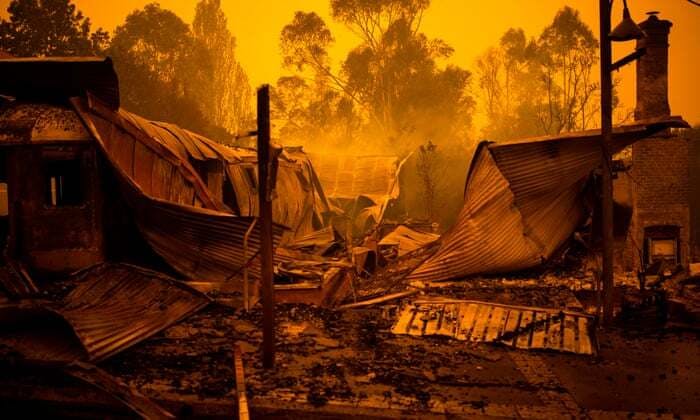Even after the bushfires, the eco-vandalism continues

More than a billion animals perished, 3,000 homes were destroyed, and 18 million hectares were burned in Australia’s catastrophic 2019-20 summer of bushfires. But, as health experts feared, we now know that the impact on people was similarly disastrous.
According to a study presented to the Royal Commission into National Natural Disaster Arrangements, smoke from the fires affected 80 percent of the population and led directly to the death of 445 people, the hospitalisation of 3,340 and the treatment of 1,373 in hospital emergency departments.
The Australian government bears the most responsibility for this suffering and death. It was warned to expect an exceptionally harsh bushfire season, but did little to prepare. This complacency, combined with the scandalous downplaying of the role of climate change in the unprecedented fires, prompted more than 100,000 people to rally around the country demanding prime minister Scott Morrison’s resignation, more resources for firefighters and immediate climate action.
If there was any hope that this disaster would be a wake-up call and that the government might finally heed the advice of climate scientists, the past few weeks have dashed it. In response to the economic downturn caused by COVID-19, the government has signalled its intention to ramp up investment into liquefied natural gas (LNG) projects as part of a “gas-fired recovery”. Such an expansion of fossil fuel extraction will lock in future catastrophes on an even greater scale.
The same politicians who travel to fire-devastated communities pretending they care about ordinary people are knowingly condemning us to a more dangerous and deadly future. Analysis by the World Weather Attribution group found that global warming increased the likelihood of last year’s bushfires by at least 30 percent. If global temperatures rise by two degrees, as seems increasingly unavoidable, similar conditions are projected to occur at least four times more often.
As it currently stands, the government’s formal emissions reduction commitment – a 26-28 percent cut in greenhouse gas emissions by 2030 compared with 2005 levels – is not enough to meet the goals of the Paris agreement, goals which most climate scientists agree are not adequate to avoid catastrophic warming anyway. And according to resources minister Angus Taylor, Australia is not on track to meet even its current inadequate commitment. Projections from the Department of the Environment and Energy suggest that pollution will be only 4 percent lower in 2030 than it is today.
Australia currently accounts for 1.3 percent of global emissions from fossil fuel combustion, or 4.8 percent if emissions from exports are included. This is massive for a country with just 0.3 percent of the world’s population. And Australia’s contribution is set to grow: the science and policy institute Climate Analytics estimates that by 2030 Australia will have increased its contribution to global greenhouse gases emissions to about 13 percent, and that is without taking into account the gas projects announced during the pandemic.
While there is hope that heavy state intervention as part of the post-pandemic recovery will provide an opportunity for “green renewal”, signs point in the opposite direction. A leaked draft report from the manufacturing task force advising the National COVID-19 Coordination Commission recommends that the government build new fossil fuel infrastructure, such as a $6 billion trans-Australian pipeline, lift moratoriums on gas in NSW and Victoria and implement extensive subsidy schemes and partnerships to “create the market” for gas in Australia. Scandalously, several members of this task force are also major players in the oil and gas industries, and the chair of the commission itself, Nev Power, was until recently the vice-chairman of gas company Strike Energy.
The Morrison government is trying to portray the expansion of gas as a win for climate action. LNG is touted as a “bridging” fuel, helping to plug the hole left by coal as the energy sector slowly transitions to fully renewable. But the premise of the argument – that LNG has a significantly lower carbon impact than other fossil fuels – has been strongly challenged by recent studies.
Gas extraction through fracking discharges methane, which has a greenhouse effect that is 72 times more potent than that of carbon dioxide. And the human contribution to fossil methane emissions may have been underestimated by up to 40 percent, according to one study. Fracking also has a number of other negative environmental impacts, such as poisoning public water supplies, causing earthquakes and consuming huge amounts of water.
It might seem contradictory that the government is clinging to fossil fuels when, for example, global investor groups representing more than $55 trillion in assets and a broad range of mainstream economists support policies aimed at reorienting to renewables. They argue it is in the best interests of the global economy to take the climate crisis seriously, since the effects of climate change will be far more disruptive than structural adjustments made in the here and now.
The problem is, capitalism is not rational. It is a dog-eat-dog system in which the pressures of competitive accumulation force capitalists and states to put immediate needs first. The economic downturn means that restoring profits as quickly as possible is the priority. Since there is no cheap way to reorient the fossil fuel-dependent Australian economy, long term plans get put aside for short term gains, which means locking in long term dependencies and environmental destruction.
Capital’s interests are not society’s nor the planet’s interests. So long as it endures, capitalism will continue to threaten the natural world and everything dependent on it.